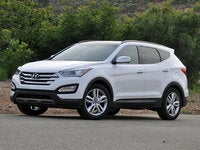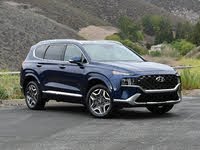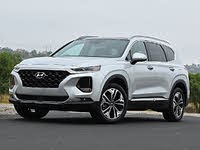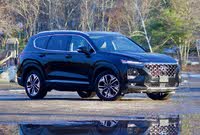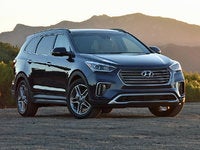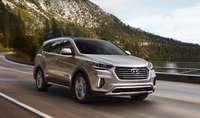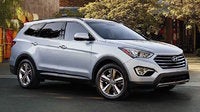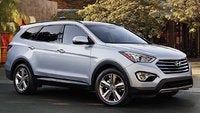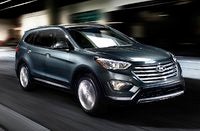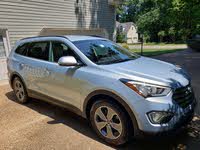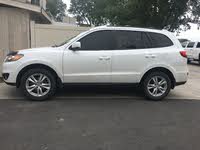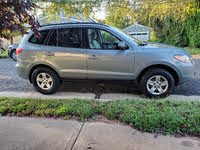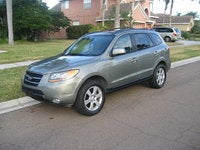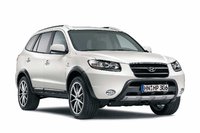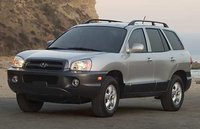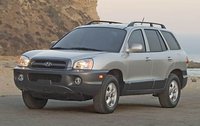Hyundai Santa Fe Model Overview
About the Hyundai Santa Fe
Available Now
The Santa Fe holds the distinction of being the first SUV offered by the South Korean automaker Hyundai, although when it debuted in 2001, the Santa Fe more accurately belonged to an emerging class of vehicles known as crossover SUVs. Based on the Sonata sedan platform, the Santa Fe took some initial hits from reviewers for its somewhat bland exterior design and meager performance, but it quickly became a bestseller in the U.S. and helped establish the Hyundai brand in the minds of American automobile buyers.
Currently nearing the end of its second generation, the Santa Fe occupies a slot in Hyundai's lineup of crossover SUVs between the entry-level Tucson and the luxury-oriented Veracruz. All three vehicles took their names from locations in the Southwest U.S. or Mexico. The Santa Fe was named for the city in New Mexico, while the Tucson borrowed its name from the southern Arizona city. The Veracruz was named after the Mexican state located in the eastern part of the country along the Gulf of Mexico.
Hyundai currently offers the Santa Fe in entry-level GLS, mid-level SE, and top-of-the-line Limited trims. All feature front-wheel drive or optional all-wheel drive (AWD) and seat five passengers in two rows. A third-row bench seat, which expanded seating to seven, was available for a few years starting in 2007, during the Santa Fe's second generation, but was discontinued in 2010.
A 175-hp, 2.4-liter four-cylinder engine powers the SE and front-wheel-drive Limited trims, while a 276-hp, 3.5-liter V6 drives the SE and AWD Limited trims. A six-speed manual transmission comes standard in the GLS, while the SE and Limited trims come equipped with a six-speed automatic with the Shiftronic manual-shift feature. Fuel economy numbers for the four-cylinder engine check in at 19/26 mpg for front-wheel-drive trims with the manual transmission and 20/25 mpg for AWD trims. The V6 manages 20/23 mpg, which drops only slightly to 20/22 mpg for trims with AWD.
Although the Santa Fe still doesn't quite stand out from the crowd, according to many reviewers, it delivers a good overall value, thanks in part to its long list of standard features, including woodgrain interior trim, steering-wheel-mounted audio and cruise controls, Bluetooth, a trip computer, and XM satellite radio. The Santa Fe also receives positive marks for its fuel economy and overall performance.
The Santa Fe received a mid-generation refresh in 2010, which included an updated body-color grille, revised taillights, and new alloy wheels, as well as the expanded list of standard features. With the current generation dating back to 2007, a third-generation Santa Fe should arrive in showrooms for the 2012 or 2013 model year. In addition, Hyundai introduced its Santa Fe Blue Hybrid vehicle at the Paris Auto Show in 2008, and although rumors persist that it's headed to the U.S., it still hasn't appeared in showrooms. With the Hybrid Sonata due at American dealerships in the early part of 2011, can the Hybrid Santa Fe be far behind?
Model History
When the Santa Fe debuted in 2001, it was one of the first SUVs sitting on a car-like platform, rather than one derived from trucks, like many of the SUVs of the era. Other new, similar vehicles at the time, also riding on car-like platforms, included the Toyota Highlander, the Honda Pilot, and the Ford Escape. Since those early days, the midsize crossover SUV market segment has exploded to include more than 20 vehicles, including the Ford Edge, Chevy Traverse, Nissan Murano, Kia Sorento, and the Mazda CX series.
A relative newcomer to the automotive market, Hyundai initially developed a reputation for a lack of build quality and reliability in its vehicles. The automaker relied on a low entry-level price point to drive sales for the Santa Fe, and it worked. In addition, the Santa Fe came with a solid warranty program, including a 10-year/100,000 limited powertrain warranty, which helped ease the concerns of prospective buyers.
The first-generation Santa Fe sat on a 103.1-inch wheelbase and had an overall length of 177.2 inches. It came in GL, GLS, and LX trim levels, with a choice of two powerplants. A 2.4-liter four-cylinder engine developing 150 hp powered a Base GL trim, while a more capable 180-hp, 2.7-liter V6 engine drove the V6 GL, GLS and top-of-the-line LX trims. The engines linked to either a five-speed manual transmission or a four-speed automatic with a manual shift mode.
When equipped with the V6, the Santa Fe had a towing capacity of 3,500 pounds. In addition, buyers could equip the V6 trims with all-wheel drive. Hyundai offered antilock brakes as an option on all trims, while traction control was available on V6 trims.
Standard features for the first-generation Hyundai included power windows, air conditioning, a folding 60/40-split rear seat, and a CD player. The GLS trim added power door locks, keyless entry, and cruise control, while the LX trim came equipped with leather upholstery as a standard feature.
For 2003, in response to customer complaints about a lack of power, the Santa Fe received a new optional 3.5-liter V6 engine, which produced 200 hp. It came standard in the LX trim, along with a new five-speed automatic transmission. Hyundai also upgraded the LX's audio system to a Monsoon system with a 6-CD changer. In addition, all Santa Fe trims received side-impact airbags as standard equipment for 2003.
The Santa Fe received a mid-generation refresh in 2005, which included a new grille, taillights, rear bumper, and wheels. Hyundai dropped the Base GL trim from the lineup, making way for the entry-level Tucson SUV, and made the 180-hp, 2.7-liter V6 standard in all trims except the high-end LX, which retained the 200-hp, 3.5-liter V6. Inside, the Santa Fe received upgraded seat fabric and a new instrument cluster, while the LX received a power-adjustable driver's seat. In addition, antilock brakes and traction control were added to the standard equipment list for all Santa Fe trims.
The second-generation Santa Fe debuted at the 2006 North American International Auto Show for the 2007 model year. Built at Hyundai's plant in Montgomery, Ala., alongside the Sonata, with which it shares a platform, the new Santa Fe was longer, more powerful, and better equipped than the previous generation. It sat on a 106.3-inch wheelbase, an increase of 3.2 inches over the previous generation. Hyundai stretched overall length by a substantial 6.9 inches, to 184.1 inches.
The added space allowed for the addition of an optional third-row bench seat, boosting seating capacity to seven. The third-row seat split 50/50 and folded down. With both rows of seats folded down, the Santa Fe offered a maximum of 78.2 cubic feet of cargo space. The second generation's larger cabin also resulted in plenty of headroom and legroom for both front- and second-row passengers, although the third-row seat was too tight for most adult passengers.
The Santa Fe came in GLS, SE, and Limited trims for 2007. Hyundai updated the dash and added blue-lit controls, as well as illuminated cupholders. Other standard features for all trims included air conditioning, cruise control, keyless entry, power windows and door locks, and an audio system with a CD player and MP3 capability. The SE added an auto-dimming rearview mirror and steering-wheel-mounted audio controls, while the Limited came equipped with upgraded leather upholstery, heated front seats, and dual-zone automatic climate control.
Power came from two new engines. A 185-hp, 2.7-liter V6 powered the GLS trim, while the SE and Limited were upgraded to a new 3.3-liter V6 producing 242 hp. The smaller powerplant mated to a four-speed automatic transmission, while the larger V6 linked to a five-speed automatic. Both were equipped with the Shiftronic manual shift feature. Hyundai offered all-wheel drive for all trim levels.
The second-generation Santa Fe featured a unibody structure with an upgraded chassis designed to provide better handling, a more comfortable ride, and minimal body lean, as well as a tighter turning radius. Electronic stability control, front seat-mounted side airbags, and a tire pressure monitoring system were among the new safety features for the second-generation Santa Fe. The GLS rode on 16-inch wheels, while the SE and Limited received 18-inch wheels.
For the mid-generation refresh in 2010, Hyundai moved production of the Santa Fe to its plant in West Point, Ga., and discontinued the optional third-row seat to make way for the new, larger Veracruz, which became the only Hyundai SUV to offer seven-passenger seating. In addition, the automaker introduced two new engines for the Santa Fe, including the 174-hp, 2.4-liter V6 and the 276-hp, 3.5-liter V6 powerplant, which drives the two upper-level trims.
Used Versions
The Santa Fe's roomy interior, comfortable ride, long list of standard features, and affordable pricing make it a good value for used-car buyers. Prospective buyers will more than likely focus on the second-generation Santa Fe, which improved upon the first generation in numerous ways, especially in performance and handling. Most owners agree the earliest Santa Fe trims, especially those equipped with a 150-hp four-cylinder, were underpowered, and even the early Santa Fe trims sporting the 180-hp V6 strained at times during acceleration and passing. The newer V6s introduced with the second generation do a much better job at moving the Santa Fe along capably.
From the beginning, the Santa Fe excelled when it came to safety features. Side-impact airbags became standard in 2003, while antilock brakes and traction control were added to all trims in 2005. Electronic stability control and front seat-mounted side airbags joined the standard equipment list in 2007 for the second-generation Santa Fe, which earned a Top Safety Pick nod from the IIHS and a five-star safety rating from the NHTSA, making it a good choice for buyers who place a premium on safety features.
The second-generation Santa Fe also offers more interior cabin space than the first generation, as well as updated controls and a new dashboard that received positive comments from reviewers. In addition, buyers who seek an optional third-row seat for seven-passenger capacity should look for Santa Fe trims produced from 2007 to 2009.
The large rear-seat head restraints in the first-generation Santa Fe caused visibility problems out the back for some drivers. Second-generation trims remedied the problem with new headrests that lowered completely into the top of the seat, resolving visibility issues.
Despite all the improvements in the second-generation Santa Fe, the first-generation trims remain good options for buyers who seek a solid, affordable crossover SUV. While lacking in the performance department, it still comes well equipped, especially the upper-level trims.
New Hyundai Santa Fe


Used Hyundai Santa Fe
Hyundai Santa Fe Questions
What Is A High Mileage For A Hyundai?
I'm looking to buy a used car and I found a Hyundai with 70,000 miles. Is that a lot or will it last me for a while?
Comfort In Driver Seat?
Does it make a difference in driver comfort within the various trims?
Why Is The Gear Not Engaging When Shift To Drive
What is the cause of 2009 Hyundai Santa Fe gear not engaging when the shift is moved to Drive
